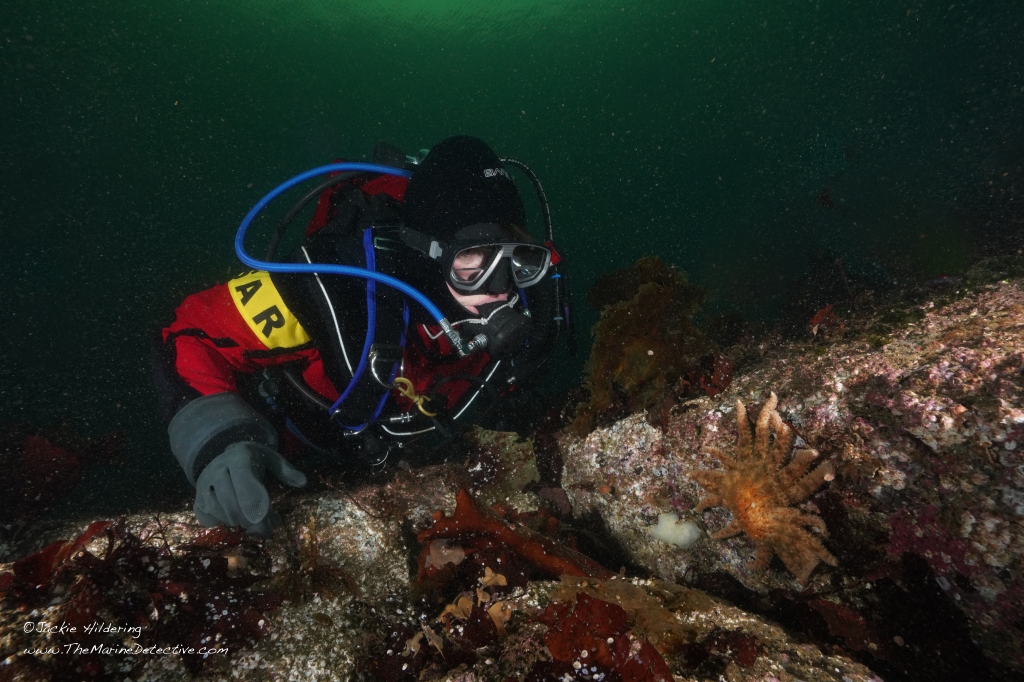It’s a Really Good Time to Be . . .
Yesterday, we found two Sunflower Stars!
See the juvenile here to the right of my buddy Natasha? There, right beside the mating Yellow-Rimmed Nudibranchs. This Sunflower Star was in just 5 metres of water.

Today’s two Sunflower Stars are the first I have seen in twelve hours underwater over the last three months and believe me, I have been looking. I only saw one before that. They are such a rarity now. Will these two survive? I have seen waves of juveniles before and then they disappear. Their plight appears to be linked to climate change.
Hope? With action . . . yes, there is shining hope.
Without action . . . no.
Please hang in there. Please read on.
I have been struggling too, looking for escape / reprieve from global realities as another “atmospheric river” is forecast to fall on parts of our province. It is so tempting to want to hide especially if we see the problems we are facing as disparate. They are not.
I have had to remind myself of the common solutions so that I see a way forward that is not guided by the faintness of blind hope; paralyzed by fear and overwhelm; and / or obfuscated by the din of values and voices that serve the few for a brief time.
Common solutions include: to know, live and share the GAINS that come from using LESS (fossil fuels, dangerous chemicals, disposables, less consumerism generally); to speak for truth and science and to have compassion for those who cannot; to exercise our power as voters and consumers to serve future generations; and to care and act on the knowledge of connection to others – across time, cultures, distance, and species.
In short, it’s a really good time to be a good human. ![]()
I had to dig for these words for myself. As always, may they serve you too.
Photos: November 21 in Kwakwaka’wakw Territory near Port Hardy at a site where I have been monitoring sea star since 2013, ©Jackie Hildering.

For those who are not yet aware, I include the reality of Sea Star Wasting Disease (SSWD) below. A link to a summary of the research and where to report sightings is in my blog at this link.

Since 2013, more than 20 species of sea star have been impacted by SSWD from Mexico to Alaska. There is local variation in intensity of the disease and which species are impacted. It is one of the largest wildlife die-off events in recorded history. Sea stars contort, have lesions, shed arms, and become piles of decay.
Currently, some species of sea star appear to have recovered while others remain very heavily impacted. Sunflower Stars (Pycnopodia helianthoides) have been devastated and were added to the International Union for Conservation of Nature (IUCN) list as Critically Endangered. There are current efforts to have Sunflower Stars assessed by the Committee on the Status of Endangered Wildlife in Canada (COSEWIC) with hopes that they receive protection under Canada’s Species at Risk Act.
There is NOT scientific consensus about the cause. Current hypotheses focus on (i) a virus and (ii) low oxygen at the surface of the sea star’s skin maintained due to bacteria. What is consistent in is that changing environmental conditions appear to allow the pathogen (be it bacteria or viruses) to have a greater impact.
The best current source for a summary of the research is Hamilton et al (August, 2021). From that source: ” . . . outbreak severity may stem from an interaction between disease severity and warmer waters” and “Though we lack a mechanistic understanding of whether temperature or climate change triggered the SSWD outbreak, this study adds to existing evidence that the speed and severity of SSWD are greater in warmer waters”.
What I believe to be the reality off the coast of British Columbia is that there are refuges of Sunflower Stars at depth where it is colder. They spawn with some young then settling in the shallows where they may succumb to the pathogen if stressed by warmer water.



